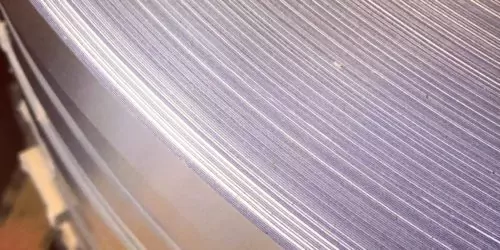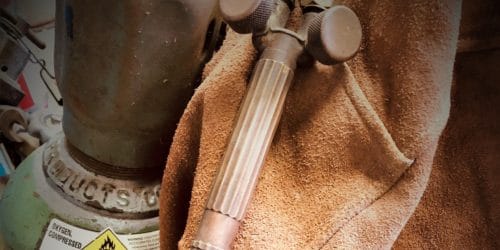When you are looking for nameplates, you are faced with a series of choices. You have to select the sizing, shape, design, process, and material.
What if I don’t know anything about different types of metal?
You don’t have to be an expert in metal nameplates to know which material you need.
This guide will walk you through the basics of the three most popular name plate materials: aluminum, stainless steel, and brass.
Types of Metal Nameplates
Nameplates are typically categorized by material. The type of metal used determines how durable a nameplate is, how much it weighs, and the applications it’s best suited for. Some materials are built for harsh industrial settings, while others are chosen for their appearance or lightweight design.
Below, we explore the most common options and what makes each one a good fit for different applications.
Aluminum
Aluminum is an all-around useful metal. From soda cans to aircraft parts, aluminum does it all. High durability and lightweight make it a great option for many applications. This holds true for metal nameplate usage as well. Due to its outstanding versatility, aluminum is one of the best choices for metal nameplate materials.
Durability
When you need your nameplates to hold up to heavy usage, aluminum is an excellent choice. It is a very resilient metal. While it’s certainly not bulletproof, it can tackle tough working conditions.
A key factor in the durability for any material is the environment it will be used in. Many nameplates face inclement weather, chemicals, or workplace wear and tear. All of these factors will impact the lifespan of the material.
Aluminum nameplates are rated to last for many years. The only change in durability is the process you choose for your nameplates. For instance, with screen printing, the ink fades and wears very quickly in outdoors applications. You only see about 1-3 years of effective use before needing to replace.
However, other processes will last significantly longer. For example, MetalPhoto designs will not wear until the aluminum does. This is because the design is embedded in the material itself.
The same holds true for embossed or stamped aluminum nameplates. All three of these processes are rated for 20+ years outdoors.
Versatility
Aluminum is a highly versatile material. It showcases the durability that metal brings to the table with the toughness to withstand heavy usage. One drawback with durability is typically having to use heavy and clunky material.
Compared to most other metals, aluminum is extremely lightweight. This gives it the freedom to be used in applications where other materials will not work.
Another added benefit is the option to color the metal through anodization. The anodization process can add any solid color of your choosing to the aluminum.
This creates new possibilities for customization. Whether you need a yellow warning sign or a company branded asset nameplate, anodization can give you the customization you desire.
Industries That Use Aluminum Nameplates
- Aerospace
- Industrial
- Transportation
- Energy
- Government
- Defense
- And More
Industries
Aluminum nameplates are used by a vast number of industries. This includes everything from energy to government to transportation and more.
One industry of note is the aerospace industry. The aerospace industry has high standards and strict specifications which have to be met. Durability and weight are incredibly important for this industry. Aluminum nameplates offer the resilience they need, while not adding significant weight.
Processes That Use Aluminum
There are a variety of processes that can be applied to a metal nameplate. Here are a few:
- MetalPhoto (Only available in aluminum)
- Blanks
- Stamped
- Embossed
- Etched
- Engraved
- Screen Printing
MetalPhoto
A major benefit to using aluminum material is the ability to utilize the MetalPhoto process. MetalPhoto is a unique process using a special anodized aluminum. A design is embedded in the material and protected by an anodic layer.
It has the appearance of printed ink, but durability on par with embossing or stamping. Plus, MetalPhoto is significantly more customizable. You have the ability to add any design, data, image, or information.
On top of unlimited customization, the nameplates are also extremely resilient. They are rated for 20+ years outdoors. Since there is no ink on the surface of the material, the design can’t fade or be worn away.
The MetalPhoto process is only available using aluminum material due to the anodization process.
Stainless Steel
Some need nameplates that will hold up to anything and everything you throw at them. Stainless steel nameplates are up for the challenge. The material is incredibly sturdy. It is tough enough to handle weather, wear and tear, and chemicals. For applications with the most extreme environments, stainless steel is a great solution.
What Are Stainless Steel Nameplates Used For?
Stainless steel has the ability to be used in many different applications. It is one of the most popular choices for nameplates because of its extreme durability.
One drawback to great durability is that it is often a heavy material. In comparison with aluminum, stainless steel is much heftier. While your nameplates will be much more durable, they will also add weight to the application in which they are used.
Weight of the nameplate might not be important to your needs, but for some industries it is crucial. For example, the aerospace industry has very strict weight specifications which must be followed. They typically use lighter materials such as aluminum to avoid these issues.
Mounting Methods for Stainless Steel Nameplates
Methods of mounting metal nameplates include adhesive backing, holes, and directly welding it to a surface.
Welding
The most common methods of applying metal nameplates is adhesive backing, holes, or directly welding to a surface.
Stainless steel is perfectly suited for welding purposes. It is often preferred over brass or aluminum as it can be easier to work with in welding applications.
Adhesive Backing
This method is ideal for attaching a metal nameplate to a smooth, clean surface. It works best for indoor applications where temperature fluctuations, moisture, and chemical exposure are minimal.
Adhesives used to mount metal name plates vary in strength, so be sure to choose one designed for the specific surface and environment you’re working with. This prevents peeling or detachment over time. For instance, an industrial-grade adhesive is an excellent option if the nameplate is exposed to moisture, chemicals, or extreme temperatures.
Holes
Holes can be drilled into metal nameplates during production. To affix nameplates, screws or rivets are inserted through these holes and secured to the mounting surface, ensuring a strong and stable attachment.
Durability
Stainless steel is one of the most durable materials used for nameplates. Stainless nameplates can handle the most rigorous environments. This includes inclement weather conditions, harsh chemicals, and tough work places.
In addition, stainless material is typically resistant to extreme temperatures heat, making it a preferred choice for crematories and other applications with high heat.
Some processes will impact the longevity of your information on the stainless nameplate. Processes that use ink such as screen printing will not last very long. Processes that indent the metal itself (stamping, embossing) have the highest level of resilience. For example, etched nameplates last around 5-10 years. However, embossed stainless nameplates will hold up for 20+ years.
If durability is the biggest factor in your decision making process, stainless steel is an excellent material choice.
Industries That Use Stainless Steel
- Aerospace
- Industrial
- Transportation
- Energy
- Government
- Defense
Industries
From industrial manufacturing to power generation to construction – if there’s an industry with tough conditions, they use metal nameplates for identification. Stainless steel is a solution many industries turn to when they know their nameplates are going to be put in tough environments.
Processes that Use Stainless Steel
- Embossed
- Stamped
- Etched
- Cable Ties
Stainless Embossed Nameplates
One of the best uses for stainless steel is embossed nameplates. The embossing process means the information is raised up in the metal. Since there is no printing or ink, the design will not be lost to wear. There are endless uses for the nameplates as well. Plus if they are painted over, the message will remain legible.
Keep in mind that other materials such as aluminum can also be used for embossing if it better fits the application.
If you are looking for the most durable nameplate solution, stainless steel embossed tags are an excellent fit.
Brass
When deciding on material for your metal nameplates, you are not just limited to aluminum and steel. You also have the choice of brass. Brass is a durable material that can withstand adverse conditions. It also has a unique look which sets it apart from the other metal nameplate material options. Whether it’s a cable tie or an embossed nameplate, brass is a solid choice.
What are Brass Nameplates Used For?
Brass nameplates are often used in plumbing and electrical applications. This is due to its ability to handle water and electrical environments well. The material is highly durable, and has a long lasting life. It is softer than other metals, which can have a substantial impact on usage.
Durability
Compared to other nameplate substrates, brass is on par for durability. Unlike aluminum, brass is much heavier. While stainless steel and aluminum will maintain their appearance over their life span, brass will discolor, wear, and tarnish. However, this is seen as a pro or a con depending on your usage and preferences.
Industries that Use Brass
- Electrical
- Plumbing
- Industrial
Appearance
Unlike the silver look of aluminum or stainless steel, brass features a golden color. This is one way to make your name plates stand out.
Another unique aspect of brass is that the look will change dramatically over time. As the material gets worn, it develops a tarnished finish.
There are a wide variety of users, each with their own preferences. Some metal nameplate users prefer the vintage aesthetic. However, others would rather stick with something that looks cleaner, and performs better in all environments.
Processes That Use Brass
- Embossed
- Stamped
- Etched
- Cable Ties
What is the Best Choice?
Choosing the right material boils down to usage, environment, and preferences/requirements.
- What are you using the nameplates for?
- How are the conditions they have to hold up in?
- What requirements or preferences do you have?
In short, aluminum is an excellent all-around choice for metal nameplate material. It is incredibly tough, remarkably lightweight, and usable in too many applications to name.
With the option for anodization, adding full color to your nameplate is also possible.
Another key benefit to aluminum is the opportunity to use photo anodization. MetalPhoto nameplates provide outstanding durability, and feature any image or design. This opens up a world of customization options.
If you want the best of both worlds (durability and lightweight) aluminum is the perfect material for your metal nameplates.
What about nameplates that have to survive in the most adverse conditions? In short, stainless steel is a great solution. It can withstand (nearly) anything you can throw at it.
On top of that, stainless steel can be used for a wide range of nameplates. Whether its embossing, stamping, etching, or even cable ties, stainless can do it all.
Lastly, brass material offers a tarnished gold vintage look. It still has durability, and for certain industries is the standard.
No matter which material you choose, you will have a quality identification nameplate that will provide a solution that meets your needs.
How to Choose the Right Nameplate Material: Factors to Consider
Aluminum, stainless steel, and brass each offer unique benefits, but the best choice depends on how the nameplate will be used. When choosing a nameplate material, consider the following factors:
Environmental Conditions: If the nameplate will be exposed to moisture, chemicals, or extreme weather, consider stainless steel. Aluminum is corrosion-resistant but may not be as strong in high-impact settings. Brass holds up well in indoor or electrical applications but will tarnish over time.
Industry Standards: Some industries have specific material requirements. For example, aerospace and defense applications often require anodized aluminum, while high-temperature environments call for stainless steel.
Weight Considerations: Aluminum is significantly lighter than stainless steel, making it ideal for applications where weight matters, such as aircraft or mobile equipment labeling.
Aesthetic Preferences: If appearance is a priority, you might go with brass. This metal nameplate material develops a patina over time, creating a vintage look. Meanwhile, stainless steel provides a long-lasting polished finish.
By evaluating these factors, you can choose the material that best meets your business’s needs. Or reach out today to discover your custom metal solution.


